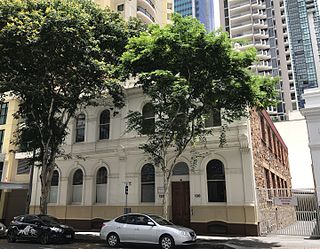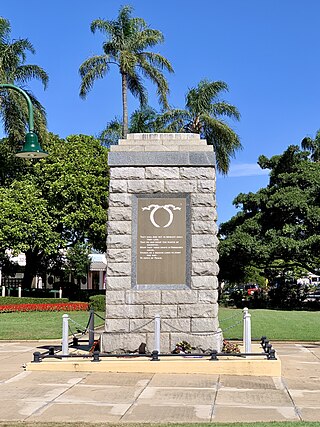
Queens Gardens is a heritage-listed park located on a city block between George Street, Elizabeth Street and William Street in the Brisbane CBD, City of Brisbane, Queensland, Australia. It was built from c. 1905 to 1990s. It is also known as Executive Gardens and St Johns Church Reserve. It was added to the Queensland Heritage Register on 21 October 1992.

Brisbane City is the central suburb and central business district of Brisbane, the state capital of Queensland, Australia. It is colloquially referred to as the "Brisbane CBD" or "the city". It is located on a point on the northern bank of the Brisbane River, historically known as Meanjin, Mianjin or Meeanjin in the local Aboriginal Australian dialect. The triangular shaped area is bounded by the median of the Brisbane River to the east, south and west. The point, known at its tip as Gardens Point, slopes upward to the north-west where the city is bounded by parkland and the inner city suburb of Spring Hill to the north. The CBD is bounded to the north-east by the suburb of Fortitude Valley. To the west the CBD is bounded by Petrie Terrace, which in 2010 was reinstated as a suburb.

Mooneys Building is a heritage-listed warehouse at 130–132 Mary Street, Brisbane City, City of Brisbane, Queensland, Australia. It was designed by Francis Drummond Greville Stanley and built in 1883 by James S Martin. It was added to the Queensland Heritage Register on 22 June 1993.

The Sir William Glasgow Memorial is a heritage-listed statue of Sir William Glasgow in Post Office Square at 270 Queen Street, Brisbane CBD, City of Brisbane, Queensland, Australia. It was designed by Daphne Mayo and built from 1961 to 1964. It was added to the Queensland Heritage Register on 13 May 2004.

Albert Street Uniting Church is a heritage-listed Uniting church at 319 Albert Street, Brisbane City, City of Brisbane, Queensland, Australia. It was designed by George Henry Male Addison and built from 1888 to 1889 by Thomas Pearson & Sons. It was originally known as Albert Street Methodist Church and Central Methodist Mission. It was added to the Queensland Heritage Register on 21 October 1992.

Tattersalls Club is a heritage-listed club house at 206 Edward Street, Brisbane City, Queensland, Australia. It was designed by Hall and Prentice and built from 1925 to 1949. It was added to the Queensland Heritage Register on 21 October 1992.

Wheat Creek Culvert was a heritage-listed culvert at Adelaide Street, Brisbane City, Queensland, Australia. It was designed by Christopher Porter and built in 1861 by H C Love. It is also known as Big Creek Culvert. It was added to the Queensland Heritage Register on 24 January 2003, but was removed in June 2015 after it was destroyed to create the Inner Northern Busway. However, a short section was preserved as a feature in the King George Square busway station.

Windsor Shire Council Chambers is a heritage-listed former town hall at 356 Lutwyche Road, Windsor, City of Brisbane, Queensland, Australia. It was designed by architect Thomas Coutts and built from 1896 to 1897 by William Parsons. It is also known as Windsor Town Council Chambers. It was added to the Queensland Heritage Register on 21 October 1992.

Sandgate War Memorial Park is a heritage-listed memorial at 8 Seymour Street, Sandgate, City of Brisbane, Queensland, Australia. It was designed by George Gray Prentice and built from 1923 to 1924 by Lowther & Sons. It was added to the Queensland Heritage Register on 3 October 2005.

Centenary Place is a heritage-listed park at 85 Wickham Street, Fortitude Valley, City of Brisbane, Queensland, Australia. It is also known by some as Centenary Park even though this is not the name it was given at the ceremonial dedication. It was designed by Henry Moore. It was added to the Queensland Heritage Register on 6 August 2007.

William Street retaining wall is a heritage-listed embankment at William Street, Brisbane City, City of Brisbane, Queensland, Australia. It was built from 1889 to 1970s. It is also known as William Street & Queens Wharf Road retaining walls and North Quay porphry wall. It was added to the Queensland Heritage Register on 21 October 1992.

The R Martin & Co Building is a heritage-listed warehouse at 41 Edward Street, Brisbane City, City of Brisbane, Queensland, Australia. It was designed by Alexander Brown Wilson and built from 1885 to 1886 by Thomas Rees. It is also known as the South East Queensland Water Board Building, Brisbane & Area Water Board Building and Geedeejay House. It was added to the Queensland Heritage Register on 21 October 1992.

Petrie Bight Retaining Wall is a heritage-listed embankment at 443–501 Queen Street, Brisbane City, City of Brisbane, Queensland, Australia. It was built from 1881 to 1882 by Henry Patten. It was added to the Queensland Heritage Register on 21 October 1992.

The Moreton Bay Penal Settlement operated from 1825 to 1842. It became the city of Brisbane, Queensland, Australia.

James Sangster Memorial is a heritage-listed memorial at Browns Park, Downs Street, North Ipswich, City of Ipswich, Queensland, Australia. The memorial was erected to commemorate the heroism of police constable James Sangster who drowned attempting to save two people. It was designed and built in 1898 by C Wilson & Co. It was added to the Queensland Heritage Register on 18 September 2008.

Miriam Vale War Memorial is a heritage-listed memorial at Blomfield Street, Miriam Vale, Gladstone Region, Queensland, Australia. It was built in 1921. It was added to the Queensland Heritage Register on 21 October 1992.

Anzac Memorial Park is a heritage-listed memorial and park at The Strand, Townsville CBD, City of Townsville, Queensland, Australia. It was first built in 1912. It is also known as The Strand Park and Townsville War Memorial. It was added to the Queensland Heritage Register on 21 October 1992.

FDA Carstens Memorial is a heritage-listed memorial at Macrossan Street, Port Douglas, Shire of Douglas, Queensland, Australia. It was built from 1907 to 1908 by Melrose & Fenwick (Townsville). It was added to the Queensland Heritage Register on 9 September 2003.

Barcaldine War Memorial Clock is a heritage-listed memorial at Ash Street, Barcaldine, Barcaldine Region, Queensland, Australia. It was designed and built in 1924 by monumental masons Andrew Lang Petrie and Son. It was added to the Queensland Heritage Register on 21 October 1992.

Cunnamulla War Memorial Fountain is a heritage-listed memorial at John Street, Cunnamulla, Shire of Paroo, Queensland, Australia. It was built c. 1924. It was added to the Queensland Heritage Register on 21 October 1992.

























